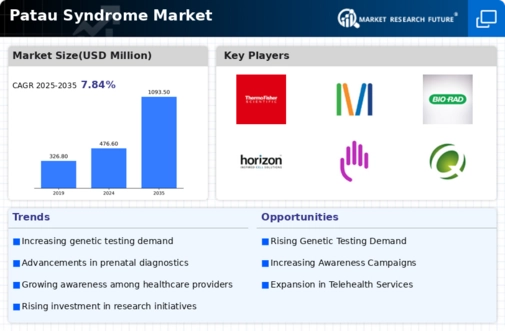Increased Research Funding
The surge in research funding dedicated to genetic disorders is a critical driver for the Patau Syndrome Market. Governments and private organizations are increasingly investing in studies aimed at understanding the genetic mechanisms underlying conditions like Patau Syndrome Market. This influx of funding supports the development of new therapies and interventions, which may improve patient outcomes. Recent statistics indicate that funding for genetic research has seen a year-on-year increase of approximately 15%, reflecting a growing commitment to addressing these complex disorders. As research progresses, it is anticipated that novel treatment options will emerge, further propelling the Patau Syndrome Market forward.
Emergence of Personalized Medicine
The emergence of personalized medicine is poised to transform the Patau Syndrome Market. Advances in genomics and biotechnology are enabling healthcare providers to tailor treatments based on individual genetic profiles. This approach holds promise for improving the efficacy of interventions for patients with Patau Syndrome Market. As personalized medicine gains traction, it is likely to lead to more effective management strategies and improved patient outcomes. Current projections suggest that the personalized medicine market could reach a valuation of over 2 trillion dollars by 2030, indicating a substantial opportunity for growth within the Patau Syndrome Market. This shift towards individualized care may redefine treatment paradigms and enhance the quality of life for affected individuals.
Growing Demand for Support Services
The growing demand for support services for families affected by Patau Syndrome Market is shaping the Patau Syndrome Market. As awareness of the condition increases, families are seeking comprehensive support, including counseling, educational resources, and community networks. This demand is prompting healthcare providers and organizations to develop tailored services that address the unique challenges faced by these families. Market analysis suggests that the support services sector is expanding, with a projected growth rate of around 8% annually. This trend indicates a shift towards holistic care models that encompass not only medical treatment but also emotional and social support, thereby enhancing the overall landscape of the Patau Syndrome Market.
Rising Awareness of Genetic Disorders
The increasing awareness surrounding genetic disorders, including Patau Syndrome Market, is a notable driver in the Patau Syndrome Market. Educational campaigns and advocacy groups are actively promoting understanding of genetic conditions, which may lead to earlier diagnosis and intervention. As awareness grows, more families are likely to seek genetic counseling and testing, thereby expanding the market. According to recent data, the prevalence of Patau Syndrome Market is estimated at 1 in 10,000 live births, which underscores the necessity for improved diagnostic tools and support systems. This heightened awareness not only encourages research funding but also stimulates demand for innovative therapies and interventions, ultimately shaping the landscape of the Patau Syndrome Market.
Technological Advancements in Diagnostics
Technological advancements in diagnostic tools are significantly influencing the Patau Syndrome Market. Innovations such as non-invasive prenatal testing (NIPT) and advanced imaging techniques have improved the accuracy and accessibility of early detection. These technologies allow for the identification of chromosomal abnormalities, including those associated with Patau Syndrome Market, at earlier stages of pregnancy. The market for prenatal testing is projected to grow substantially, with estimates suggesting a compound annual growth rate of over 10% in the coming years. As these technologies become more widely adopted, they are likely to enhance the overall understanding and management of Patau Syndrome Market, thereby driving growth in the Patau Syndrome Market.


















Leave a Comment